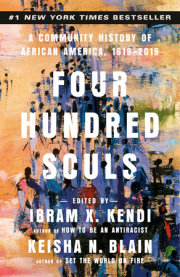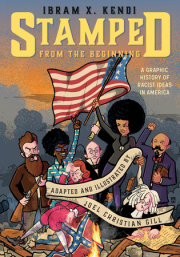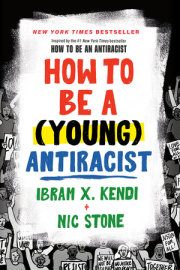Chapter 11619–1624ArrivalNikole Hannah-Jones
Four hundred years ago, in 1620, a cargo ship lowered its anchor on the eastern shore of North America. It had spent sixty-six grueling days on the perilous Atlantic Ocean, and its 102 passengers fell into praise as they spotted land for the first time in more than two months.
These Puritans had fled England in search of religious freedom. We know all their names, names such as James Chilton, Frances Cook, and Mary Brewster. Their descendants proudly trace their lineage back to the group that established self-governance in the “New World” (that is, among the white population—Indigenous people were already governing themselves).
They arrived on the Mayflower, a vessel that has been called “one of the most important ships in American history.” Every fall, regaled by stories of the courageous Pilgrims, elementary school children whose skin is peach, tan, and chestnut fashion black captain hats from paper to dress up like the passengers on the Mayflower. Our country has wrapped a national holiday around the Pilgrims’ story, ensuring the Mayflower’s mythical place in the American narrative.
But a year before the Mayflower, in 1619, another ship dropped anchor on the eastern shore of North America. Its name was the White Lion, and it, too, would become one of the most important ships in American history. And yet there is no ship manifest inscribed with the names of its passengers and no descendants’ society. These people’s arrival was deemed so insignificant, their humanity so inconsequential, that we do not know even how many of those packed into the White Lion’s hull came ashore, just that “some 20 and odd Negroes” disembarked and joined the British colonists in Virginia. But in his sweeping history Before the Mayflower, first published in 1962, scholar Lerone Bennett, Jr., said of the White Lion, “No one sensed how extraordinary she really was . . . [but] few ships, before or since, have unloaded a more momentous cargo.”
This “cargo,” this group of twenty to thirty Angolans, sold from the deck of the White Lion by criminal English marauders in exchange for food and supplies, was also foundational to the American story. But while every American child learns about the Mayflower, virtually no American child learns about the White Lion.
And yet the story of the White Lion is classically American. It is a harrowing tale—one filled with all the things that this country would rather not remember, a taint on a nation that believes above all else in its exceptionality.
The Adams and Eves of Black America did not arrive here in search of freedom or a better life. They had been captured and stolen, forced onto a ship, shackled, writhing in filth as they suffered and starved. Some 40 percent of the Angolans who boarded that ghastly vessel did not make it across the Middle Passage. They embarked not as people but as property, sold to white colonists who just were beginning to birth democracy for themselves, commencing a four-hundred-year struggle between the two opposing ideas foundational to America.
And so the White Lion has been relegated to what Bennett called the “back alley of American history.” There are no annual classroom commemorations of that moment in August 1619. No children dress up as its occupants or perform classroom skits. No holiday honors it. The White Lion and the people on that ship have been expunged from our collective memory. This omission is intentional: when we are creating a shared history, what we remember is just as revelatory as what we forget. If the Mayflower was the advent of American freedom, then the White Lion was the advent of American slavery. And so while arriving just a year apart, one ship and its people have been immortalized, the other completely erased.
W.E.B. Du Bois called such erasure the propaganda of history. “It is propaganda like this that has led men in the past to insist that history is ‘lies agreed upon’; and to point out the danger in such misinformation,” he wrote in his influential treatise Black Reconstruction (1935). Du Bois argued that America had falsified the fact of its history “because the nation was ashamed.” But he warned, “It is indeed extremely doubtful if any permanent benefit comes to the world through such action.”
Because what is clear is that while we can erase the memory of the White Lion, we cannot erase its impact. Together these two ships, the White Lion and the Mayflower, bridging the three continents that made America, would constitute this nation’s most quintessential and perplexing elements, underpinning the grave contradictions that we have failed to overcome.
These elemental contradictions led founder Thomas Jefferson, some 150 years later, to draft the majestic words declaring the inalienable and universal rights of men for a new country that would hold one-fifth of its population—the literal and figurative descendants of the White Lion—in absolute bondage. They would lead Frederick Douglass—one of the founders of American democracy—to issue in 1852 these fiery words commemorating an American Revolution that liberated white people while ensuring another century of subjugation for Black people:
This, for the purpose of this celebration, is the 4th of July. It is the birthday of your National Independence, and of your political freedom.
What have I, or those I represent, to do with your national independence? Are the great principles of political freedom and of natural justice, embodied in that Declaration of Independence, extended to us? Fellow-citizens; above your national, tumultuous joy, I hear the mournful wail of millions! whose chains, heavy and grievous yesterday, are, to-day, rendered more intolerable by the jubilee shouts that reach them. If I do forget, if I do not faithfully remember those bleeding children of sorrow this day, “may my right hand forget her cunning, and may my tongue cleave to the roof of my mouth!” To forget them, to pass lightly over their wrongs, and to chime in with the popular theme, would be treason most scandalous and shocking, and would make me a reproach before God and the world. My subject, then fellow-citizens, is AMERICAN SLAVERY. I shall see, this day, and its popular characteristics, from the slave’s point of view. Standing there, identified with the American bondman, making his wrongs mine, I do not hesitate to declare, with all my soul, that the character and conduct of this nation never looked blacker to me than on this 4th of July! Whether we turn to the declarations of the past, or to the professions of the present, the conduct of the nation seems equally hideous and revolting. America is false to the past, false to the present, and solemnly binds herself to be false to the future.
The contradictions between these two founding arrivals—the Mayflower and the White Lion—would lead to the deadliest war in American history, fought over how much of our nation would be enslaved and how much would be free. They would lead us to spend a century seeking to expand democracy abroad, beckoning other lands to “Give me your tired, your poor, Your huddled masses yearning to breathe free,” while violently suppressing democracy at home for the descendants of those involuntary immigrants who arrived on ships like the White Lion. They would lead to the elections—back-to-back—of the first Black president and then of a white nationalist one.
The erasure of August 1619 has served as part of a centuries-long effort to hide the crime. But it has also, as Du Bois explained in
The Souls of Black Folk, robbed Black Americans of our lineage.
Your country? How came it yours? Before the Pilgrims landed we were here. . . . Actively we have woven ourselves with the very warp and woof of this nation,—we fought their battles, shared their sorrow, mingled our blood with theirs, and generation after generation have pleaded with a headstrong, careless people to despise not Justice, Mercy, and Truth, lest the nation be smitten with a curse. Our song, our toil, our cheer, and warning have been given to this nation in blood-brotherhood. Are not these gifts worth the giving? Is not this work and striving?
Would America have been America without her Negro people?
We cannot fathom it. Black Americans, by definition, are an amalgamated people. Our bodies form the genetic code—we are African, Native, and European—that made America and Americans. We are the living manifestation of the physical, cultural, and ideological merger of the peoples who landed on those ships but a year apart, and of those people who were already here at arrival. Despite the way we have been taught these histories, these stories do not march side by side or in parallel but are inherently intertwined, inseparable. The time for subordinating one of these histories to another has long passed. We must remember the White Lion along with the Mayflower, and the Powhatan along with the English at Jamestown. As Du Bois implores, “Nations reel and stagger on their way; they make hideous mistakes; they commit frightful wrongs; they do great and beautiful things. And shall we not best guide humanity by telling the truth about all this, so far as the truth is ascertainable?”
The true story of America begins here, in 1619. This is our story. We must not flinch.
Copyright © 2021 by Ibram X. Kendi. All rights reserved. No part of this excerpt may be reproduced or reprinted without permission in writing from the publisher.


















